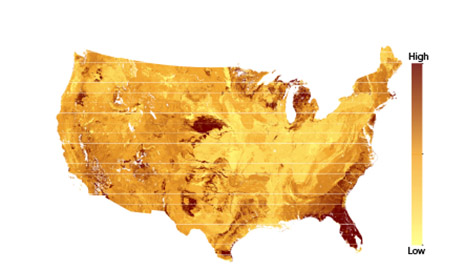Deforestation of sandy soils a greater threat to climate change

This heat map shows the areas of the United States where the soil microbial biomass is susceptible to changes in vegetation cover.
In a comprehensive analysis of soil collected from 11 distinct U.S. regions, from Hawaii to northern Alaska, researchers found that the extent to which deforestation disturbs underground microbial communities that regulate the loss of carbon into the atmosphere depends almost exclusively on the texture of the soil. The results were published in the journal Global Change Biology.
“We were astonished that biodiversity changes were so strongly affected by soil texture and that it was such an overriding factor,” said Thomas Crowther, a postdoctoral fellow at the Yale School of Forestry & Environmental Studies and lead author of the study. “Texture overrode the effects of all the other variables that we thought might be important, including temperature, moisture, nutrient concentrations, and soil pH.”
The study is a collaboration among Yale researchers and colleagues at the University of Boulder, Colorado and the University of Kentucky.
A serious consequence of deforestation is extensive loss of carbon from the soil, a process regulated by subterranean microbial diversity. Drastic changes to the microbial community are expected to allow more CO2 to escape into the atmosphere, with the potential to exaggerate global warming.
Specifically, the researchers found that deforestation dramatically alters microbial communities in sandy soils, but has minimal effects in muddy, clay-like soils, even after extensive tree removal.
According to the researchers, particles in fine, clay-like soil seem to have a larger surface area to bind nutrients and water. This capacity might buffer soil microbes against the disturbance of forest removal, they said. In contrast, sandy soils have larger particles with less surface area, retaining fewer nutrients and less organic matter.
“If you disrupt the community in a sandy soil, all of the nutrients the microbes rely on for food are leached away: they’re lost into the atmosphere, lost into rivers, lost through rain,” Crowther said. “But in clay-like soil, you can cut down the forest and the nutrients remain trapped tightly in the muddy clay.”
The researchers also examined how the effects of deforestation on microbial biodiversity change over time. Contrary to their expectations, they found no correlation, even over the course of 200 years.
“The effects are consistent, no matter how long ago deforestation happened,” Crowther said. “In a clay soil, you cut down the forest and the nutrients are retained for long periods of time and the community doesn’t change. Whereas in a sandy soil, you cut down a forest and the community changes dramatically within only a couple of years.”
Using previously documented information about soil distribution, the researchers were able to map potential areas where belowground ecosystems are more likely to be vulnerable to deforestation. This has the potential to inform land management practices concerned with the conservation of biodiversity and the sequestration of carbon in the soil.
Co-authors of the study, “Predicting the Responsiveness of Soil Biodiversity to Deforestation: A Cross-Biome Study,” include Daniel S. Maynard, Emily E. Oldfield, and Mark A. Bradford of the Yale School of Forestry & Environmental Studies.
Media Contact
All latest news from the category: Agricultural and Forestry Science
Newest articles

High-energy-density aqueous battery based on halogen multi-electron transfer
Traditional non-aqueous lithium-ion batteries have a high energy density, but their safety is compromised due to the flammable organic electrolytes they utilize. Aqueous batteries use water as the solvent for…

First-ever combined heart pump and pig kidney transplant
…gives new hope to patient with terminal illness. Surgeons at NYU Langone Health performed the first-ever combined mechanical heart pump and gene-edited pig kidney transplant surgery in a 54-year-old woman…

Biophysics: Testing how well biomarkers work
LMU researchers have developed a method to determine how reliably target proteins can be labeled using super-resolution fluorescence microscopy. Modern microscopy techniques make it possible to examine the inner workings…





















